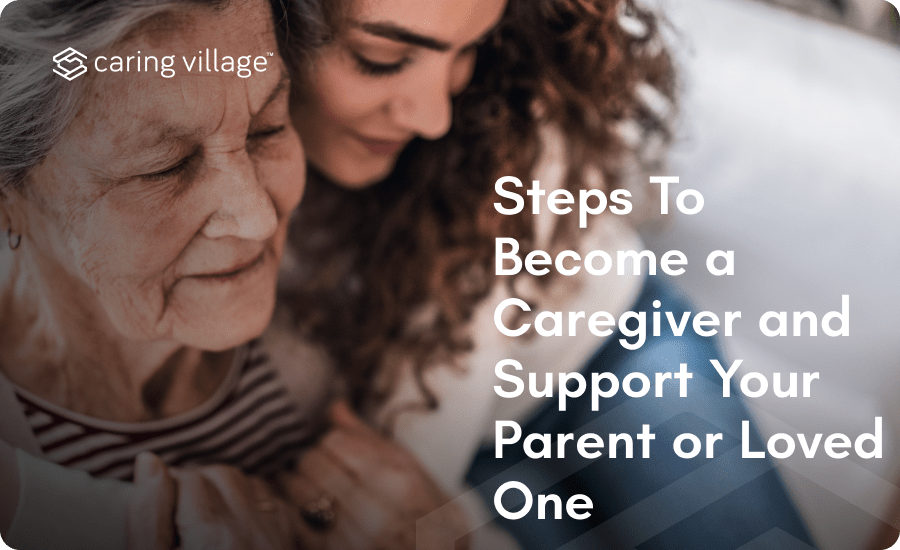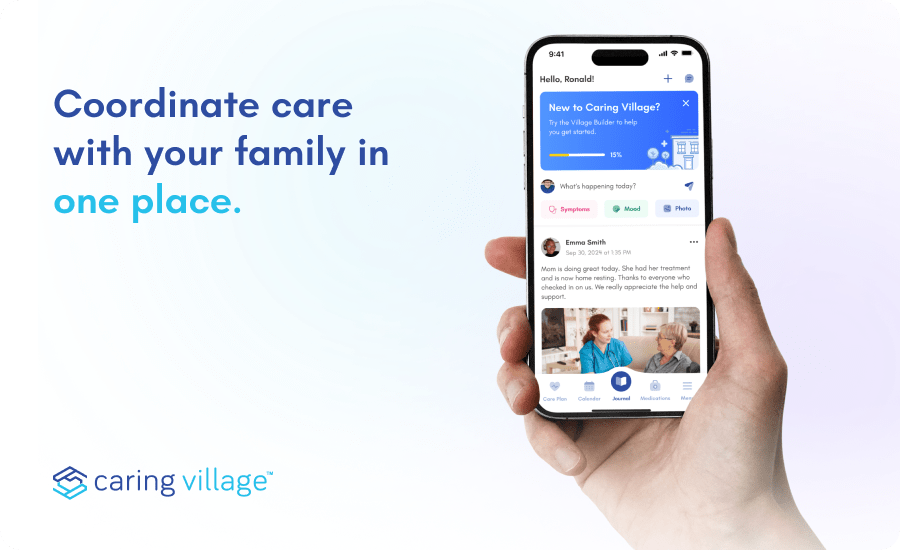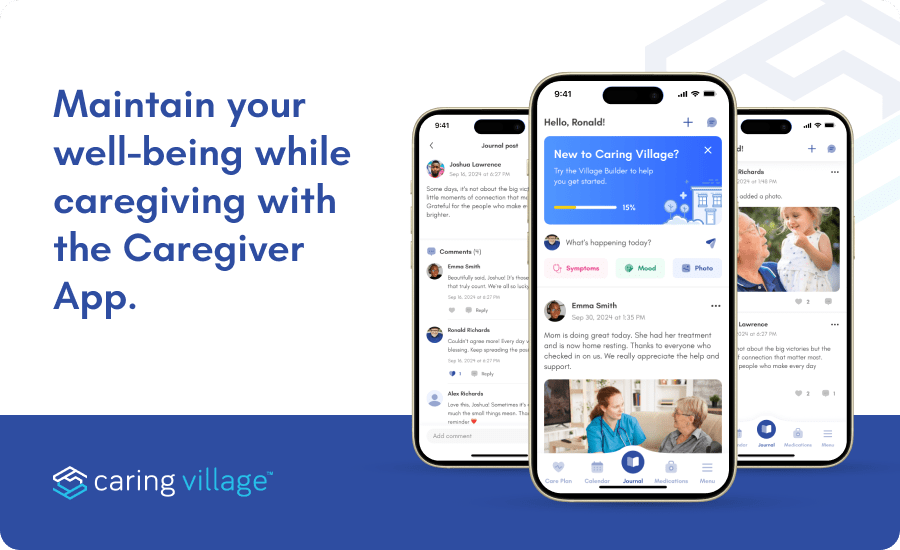
How To Become a Caregiver: Key Takeaways
- To become a caregiver, you should understand it involves emotional readiness, planning, and shared communication among family members
- Most caregivers are women balancing caregiving responsibilities with full-time jobs, highlighting the need for structure and practical tools
- Common caregiving roles include caring for parents, spouses, or friends, each with unique emotional and logistical challenges
- Building essential skills like organization, communication, and time management makes caregiving smoother and more sustainable for anyone who becomes a caregiver
- Prioritizing caregiver well-being through boundaries, rest, and long-term planning helps prevent burnout
- Tools like Caring Village bring families together by simplifying coordination, tracking care, and keeping everyone informed in one place
Stepping into the role of caregiver for a parent, spouse or loved one is a meaningful commitment. As rewarding as it is, caregiving requires coordination, planning, and deep understanding of the challenge. According to recent U.S. data, nearly 1 in 4 Americans report that they currently provide care for an adult relative or friend due to aging, disability, or illness.
Whether you live nearby or manage care from afar, from the moment you become a caregiver, it requires blending emotional support with practical action. Recognizing what this role truly involves and preparing for it thoughtfully can make the difference between feeling reactive and feeling ready.
With tools like the Caring Village Caregiver App, families can simplify communication, coordinate care tasks, and share vital information across locations, all of which helps make caregiving less chaotic and more connected.
Let’s walk through what stepping into this role really looks like:
- What it means to become a caregiver and explore the different types of caregiving relationships
- Signs you might be ready to assume caregiving responsibilities
- Challenges and rewards specific to caring for a parent
- Essential caregiver skills focused on communication, health-management and organization
- Helpful resources and tools, especially digital ones, that support family caregivers
- Practical tips for maintaining your own well-being while providing care
The decision to become a caregiver doesn’t have to feel overwhelming.
Start building your support system today with the Caregiver App.
What Does It Mean To Become a Caregiver?
When you become a caregiver, you're stepping into someone’s daily life: helping with doctor visits, meals, and medications while still honoring their need to feel in control of their own life. It often begins with small acts of support such as managing appointments, checking in by phone, or organizing medication.
That quick check-in call can turn into weekly medication management and driving to specialist appointments before you even realize it. Recent data shows how widespread this role has become. In 2024, 59% of family caregivers were women, and among them, 43% worked full time while managing caregiving responsibilities.
You’ll need patience, sure, but also calendars, backup plans, and a good sense of humor. Without some structure, the emotional work gets overwhelming fast. The more clearly you see what’s ahead—like juggling doctor visits and medication lists—the less likely you’ll feel blindsided when the hard days hit.
Different Types of Caregiving
Caregiving varies depending on who you are supporting and the type of assistance they need. The most common forms include:
- Caring for a parent: This is one of the most familiar caregiving roles. It may involve organizing medical visits, managing medications, or helping with meals and transportation. Many adult children say that after they become a caregiver they find familial roles reversed, which requires as much emotional understanding as practical support.
- Caring for a spouse or partner: When a partner experiences health changes, caregiving often becomes part of daily life. These caregivers typically balance emotional companionship with physical support and household management.
- Caring for a friend or relative: Some caregivers step in for friends, siblings, or extended family who do not have close relatives nearby. This can include companionship, managing bills, or coordinating outside services.
Caring for your dad who resists help looks different than supporting a friend with MS, but no matter the relationship, staying on the same page with others makes everything smoother.
Daily Responsibilities and Tasks
When you become a caregiver, your daily activities often depend on the care recipient’s health and level of independence. In a typical week, you might be calling in prescription refills, getting mom to her cardiology appointment, checking the fridge for groceries, and updating your siblings about how she's doing.
You’ll also find yourself:
- Monitoring medications and refills
- Scheduling and managing appointments
- Coordinating transportation or home visits
- Preparing meals or arranging grocery deliveries
- Managing household tasks and finances
- Communicating updates with other family members
Many caregivers use coordination tools like shared calendars or digital dashboards to stay organized. Caring Village was designed with these needs in mind, helping families manage communication, task lists, and important information in one secure space. For long-distance caregivers, this kind of structure is essential to ensure nothing is overlooked, and everyone stays informed.

Emotional and Practical Considerations
Helping someone you love is rewarding, but the decision to become a caregiver also means late nights, hard conversations, and real-life stress. Understanding both sides early helps build realistic expectations and healthier routines.
The main considerations include:
- Emotional readiness: Feelings of guilt, frustration, or exhaustion can appear when responsibilities grow. Recognizing these emotions is an important part of maintaining balance.
- Time and financial impact: When you become a caregiver you can expect changes to affect your work schedules, income, and personal plans. Planning ahead and sharing responsibilities among family members can prevent long-term strain.
- Support systems: Few people can sustain caregiving alone. Community organizations, online caregiver networks, and family communication tools can provide encouragement and reduce isolation.
Trying to juggle texts, updates, and schedules?
A shared digital space keeps everyone in the loop, without the phone tag.
Signs You Might Be Ready To Become a Caregiver
Caregiving often begins long before anyone calls it that. Over time, small actions can become a daily commitment that affects your schedule, emotions, and relationships.
Recognizing the signs that you are ready to take on caregiving responsibilities helps prevent burnout and promotes a smoother transition for both you and your loved one.
A 2021 study found that the majority of caregivers did not recognize themselves as caregivers, which often delayed their access to support or resources. Understanding that caregiving readiness is both emotional and practical allows families to plan early instead of reacting during a crisis.
Assessing Your Emotional Readiness
Emotional readiness is often the most important and the most overlooked factor if you’re looking to become a caregiver. It means being prepared to handle changing family roles, potential frustration, and moments of uncertainty.
Ask yourself:
- How do I respond under stress or uncertainty?
- Am I comfortable asking for help or setting boundaries?
- Do I have people I can rely on for emotional support?
Many caregivers find that journaling or tracking moods helps identify patterns of fatigue or stress. Tools like the Wellness Journal in the Caring Village app make this easier by allowing you to record reflections or track emotional well-being over time.
People who choose to become a caregiver often underestimate the emotional load of caregiving, which can lead to fatigue, and even caregiver burnout if support systems aren’t in place.
Time and Availability Considerations
Before you become a caregiver, it helps to evaluate your schedule and commitments realistically. Many people underestimate how much time caregiving requires, from routine appointments to unexpected emergencies. Even if your loved one is mostly independent, coordination and communication take time.
You might also need to consider how caregiving affects your work life. Many employers now offer flexible hours or remote options to accommodate family responsibilities. Planning ahead allows you to stay consistent and avoid feeling pulled in too many directions.
Families who live apart can still provide effective care by using shared tools to coordinate updates and responsibilities. Caring Village allows additional family members to become a caregiver so they can help organize appointments, upload documents, and communicate within a private family space, ensuring everyone stays informed no matter where they are.
Skills and Personal Strengths
Every caregiver brings a different set of strengths. Some people are natural communicators, while others excel at organization or problem-solving. Reflecting on your own strengths can help you decide which areas you can manage confidently and where you might need extra support.
Some days, it’s your patience that gets tested; other days, it’s remembering whether the 2 p.m. appointment was moved. Being flexible helps, but so does a clear plan.
Many caregivers find confidence by focusing on their strengths and connecting with others in similar roles. Supporting new family caregivers is often about learning to share responsibility, communicate clearly, and create a care plan that feels sustainable for everyone involved.
Becoming a Caregiver for a Parent: Key Challenges and Rewards
Caring for a parent is one of the most personal and emotional forms of caregiving. It represents a shift in roles that can bring families closer together, but it also introduces new responsibilities that may feel unfamiliar.
Common Challenges in Caring for Parents
Family caregiving often involves a delicate balance between honoring a parent’s independence and stepping in when help is needed. Some of the most common challenges include:
- Role reversal: Supporting a parent can feel emotionally complex, especially when they resist assistance. Adjusting to a new dynamic requires patience and empathy.
- Time management: Between work, family, and personal obligations, caregivers frequently struggle to keep up. Clear communication and planning reduce misunderstandings and stress.
- Decision-making: Coordinating medical care, finances, or living arrangements often falls to one or two family members, which can create tension if expectations are unclear.
- Emotional strain: Adult children who become caregivers frequently report anxiety or fatigue when navigating these changes alone.
Using a shared planning system helps reduce friction by keeping important updates, schedules, and tasks visible to everyone involved.
Emotional Rewards of Caregiving
While the challenges are real, many caregivers describe the experience as deeply meaningful. Supporting a parent often brings a renewed sense of connection and appreciation for shared history.
Many family caregivers find unexpected meaning in their work. In fact, the APA notes that 83% of people who become caregivers perceived their role as a positive experience.
Caring for someone you love can bring a sense of giving back, deepen purpose, and strengthen relationships, even as you manage the harder parts of care. Needless to say, proper organization remains the key factor.
Balancing Caregiving With Your Own Life
Once you have become a caregiver, balancing your own needs with caregiving responsibilities is one of the hardest parts of this journey. Emotional investment can make it difficult to prioritize rest or personal goals, yet sustainable caregiving depends on doing exactly that.
Creating a daily routine, setting boundaries, and involving other family members can ease the load. Communication tools and shared calendars, such as the ones available in the Caregiver App, make this process simpler, ensuring everyone understands what needs to be done and who is responsible for each task.
If you belong to the Sandwich Generation as adults caring for both children and aging parents, organization and teamwork become even more essential. Coordinating schedules and sharing updates digitally can reduce confusion and help maintain stability for every generation in the home.
Caring for a parent can be both emotionally rewarding and draining at the same time.
Lighten the load with Caring Village.
Essential Skills Every Caregiver Should Have
Caregiving requires more than compassion. It involves organization, adaptability, and a clear understanding of both emotional and practical needs. Building these core skills helps caregivers manage daily routines with confidence while maintaining balance in their own lives.
Communication Skills for Effective Care
Strong communication ensures that everyone involved, from family to healthcare providers, stays informed and coordinated. Good communication means listening carefully, asking clear questions, and keeping messages consistent.
Families can simplify this process by using structured communication channels. Caring Village includes a shared message board where updates, questions, and reminders can be posted in one private space.
Medical Knowledge and Managing Health Needs
Even basic medical understanding helps the non-doctor who becomes a caregiver provide safer and more confident support. Keeping track of medications, test results, and doctor instructions can feel overwhelming, so organization is key. Many caregivers use a combination of digital tools and printable health logs.
The Caregiver App document storage and medication features simplify this by allowing caregivers to store prescriptions and notes securely.
The National Institute on Aging’s website also offers printable caregivers’ worksheets that can be used alongside digital tools, including a home safety checklist, medication and supplement worksheet, and a list of important documents and paperwork.
Organizational and Time Management Skills
A structured routine helps families handle daily care without constant stress. Setting weekly schedules, assigning roles, and automating reminders are small changes that prevent chaos and save time.
Caring Village’s app includes a shared calendar where families can coordinate visits, medical appointments, or transportation.
Caregivers who prefer offline support can also explore local caregiver training programs offered by Area Agencies on Aging (AAA), which provide free time-management and care-planning workshops in many U.S. counties.
Using Technology and Apps for Caregiving
Technology can enhance organization, safety, and emotional support. Many caregivers use devices that monitor medication schedules or home safety, along with mobile apps that centralize communication.
Caring Village combines several of these functions, wellness journaling, secure document storage, and coordinated scheduling, into one easy-to-use space.

Tips for Maintaining Your Own Well-Being While Caregiving
Many caregivers spend so much time managing another person’s needs that their own health begins to suffer. According to AARP, more than 60% of people who become a caregiver report experiencing symptoms of stress, anxiety, or depression linked to their responsibilities. Protecting your well-being is an essential part of sustainable care and should not be overlooked.
Setting Boundaries and Asking for Help
Healthy caregiving begins with clear boundaries. Setting limits on your availability, sharing responsibilities, and accepting help from others are practical steps that prevent fatigue.
Families who communicate openly about schedules and expectations are better able to distribute responsibilities fairly. Caring Village makes this a breeze through shared calendar and task management features, helping everyone understand their responsibility.
When additional help is needed, community programs such as Respite Care Services through the Administration for Community Living (ACL) provide short-term relief options that allow caregivers to rest without guilt.
Self-Care Practices and Stress Management
Sometimes, just a 10-minute walk outside or a quiet coffee before the day starts can recharge you more than you’d expect. Regular exercise, nutritious meals, and scheduled downtime help restore energy and reduce stress hormones.
Mindfulness activities such as deep breathing, short walks, or journaling can improve focus and emotional balance.
You can also explore our post on caregiver burnout, which covers practical ways to recognize early signs of fatigue and regain balance.
Planning for Long-Term Care Sustainability
Caregiving often evolves as a loved one’s needs change. Planning for the long term protects both the caregiver and the care recipient from future stress.
Start by documenting medical, legal, and financial information in one secure location. Caring Village’s document storage and contact sharing make this process easier, ensuring key details are available if emergencies arise.
Families should also familiarize themselves with federal and state programs that support home-based care. Resources such as Medicaid’s Home and Community-Based Services (HCBS) and State Aging Councils can provide assistance with in-home support, transportation, and the possibility of getting paid as a caregiver.
How To Become a Caregiver: FAQs
You probably won’t get a roadmap from day one. But starting the conversation “What does Mom need right now?” is where most people begin. Begin by assessing your parent’s daily needs, medical requirements, and living preferences.
It also helps to organize important information, such as medications, appointments, and emergency contacts, in one place. You can also read more about being a caregiver for a parent to explore ways to balance independence and support.
Caregivers benefit from strong communication, patience, organization, and problem-solving. Basic medical understanding, time management, and emotional awareness are equally important.
These skills help caregivers adapt as needs change and prevent fatigue or frustration.
Caregiving apps bring structure and simplicity to complex responsibilities. The Caring Village Caregiver App combines secure document storage, a shared calendar, medication lists, and a wellness journal to keep families informed and connected, ideal for both local and long-distance caregiving.
It minimizes confusion and ensures that no message or task goes unnoticed.
What makes this doable? Knowing you’re not carrying it all alone.
The right tools just make it easier to breathe. Streamline your caregiving journey with Caring Village.
